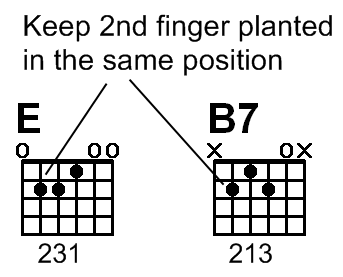Tulsa Time
Lesson Goals:
♦ Review the E and B7 chords
♦ Become familiar with the music staff and notation
♦ Play the song "Tulsa Time"
The first song we will play is “Tulsa Time”, written by Don Williams and made popular by Eric Clapton.
This is a great first song because it consists of only 2 chords, the E chord and the B7 chord that we just learned.
Let's begin by reviewing the chord positions for the E and the B7. Practice transistioning between the two chords.
Now refer to the music staff below. Notice that, in this song the E is played for 3 full measures before changing to B7.
In each measure there are 4 beats but 8 strokes so the strumming will be like you did in Lesson 2 with a combination of down strokes and up strokes.
Play the song slowly and in tempo to begin with, gradually increasing the speed with each playing.





